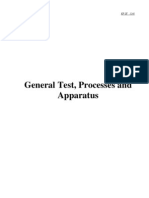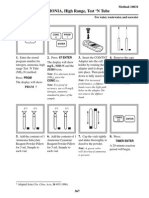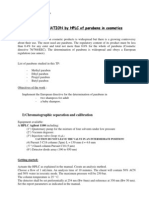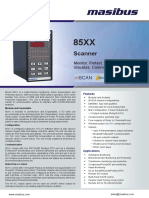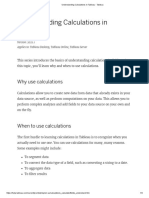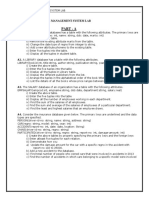Experiment CHM
Experiment CHM
Uploaded by
Hanna AnneCopyright:
Available Formats
Experiment CHM
Experiment CHM
Uploaded by
Hanna AnneOriginal Description:
Original Title
Copyright
Available Formats
Share this document
Did you find this document useful?
Is this content inappropriate?
Copyright:
Available Formats
Experiment CHM
Experiment CHM
Uploaded by
Hanna AnneCopyright:
Available Formats
Procedure: Introduction:
ANALYSIS OF MOUTHWASH
Part I: Commercial mouthwashes are mixtures of water, alcohol, dyes, flavorings, and other compounds. Prepare standard solutions of alcohol content of thethe following listbe l. This experiment will allow the ethanol according to mouthwash to using determined. If fifty ethanol. Be careful to make accurate measurements! Pipette the the 95% milliliters each of alcohol and water are mixed, the total volume of mixture will not equal and add to a 100mL volumetric flask. Then, carefully fill to the alcohol, one hundred milliliters. This reduction in volume is due the flask to attractive forces between the alcohol and water. Since the volumes of alcohol and water the 100mL line with distilled water. are not additive when mixed, a calibration curve must first be prepared. It will provide the correction needed for alcohol-water mixtures. The calibration curve will be prepared by % Volume Alcohol 95% alcohol (mL/100mL) placing a known amount of alcohol in an alcohol-water mixture. The observed percentage 5% 5.26mL of alcohol will be plotted against the true percentage of alcohol. 10% 10.53mL 20% 21.05mL 30% 31.58mL Once the calibration data is collected and plotted, samples of mouthwashes will be analyzed using the gas chromatograph. The observed percentage of alcohol will be determined and the following conditions from the edit menu calibration graph. These true percentage will be found using the by selecting 2. Set values may then be compared with the values reported by the manufacturer. channels then selecting channel 1 and temperature change. Start 140 C Hold 10 minutes Ramp 0 degrees/min Until the Purpose: temperature is 140 C 3. Obtain a experiment is to determine the amount of alcohol with the sample The purpose of this microliter syringe. Rinse the syringe several timesin a brand of to mouthwash. be tested. Then obtain 2 microliters of the sample in the syringe. 4. Insert the needle into the GC. Press the plunger, and start the run and Equipment/Materials: the same time. 5. After a peak is recorded, press the end button on the computer. ethanol distilled water 6. 100To obtain the area under the curve, or buret edit drop down menu and ml, volumetric flasks pipet select the option. Select gaschoose the Manual integration10 L syringe the rubber band icon found on chromatograph the bottom left of the graphed results. Left click and drag across the bottom mouthwash samples . of the curve to create a baseline. This will allow the program to calculate a Safety: more accurate area. 7. Select goggles then Results to obtain area data. Record results in the An apron andView and should be worn in the laboratory at all times. data table below. Complete steps this experiment should pose no significant safety 20%, The chemicals used in 3 through 5 for the following standards: 5%, 10%, hazards. and 30% alcohol. Good laboratory procedure should be followed at all times. Percent Alcohol v/v 5% 10% 20% 30% Area Due to Alcohol
9. Prepare a graph with the area on the x - axis, and the percentage of alcohol on the y - axis. Draw a "best fit" line connecting the points on your graph.
6.
7. 8.
Science theMotion 2. What was the AIR GC of ANALYSISsyringeALCOHOLS before purpose SEPARATION OF several times rinsing in OF inserting your sample into the GC?TEACHER MOUTHWASH Materials List TEACHER NOTES NOTES Lab Time: 40-50 minutes 3. How did the accepted values match the percentage of alcohol in your Lab mouthwash samples? Explain your results. Part II:Time: 45 minutes Considerations: Lab: Air GC Separation samples. 1. Obtain mouthwash of Alcohols In order to reduce the time of this lab, the alcohol standards could be prepared ahead of time. The lab could also be done not using the standards at all and just determine Number of Lab Groups Prepared: Answersinprocedure 3 the % of 2. Followto Question:through 5 from Part I with your mouthwash samples. Be alcohol the mouthwash by the area under the peaks. sure to rinse the syringe several times with the mouthwash sample you are Hardware running before you insert the needle into the GC. Equipment perimportant to run known below: of possible components in Returned 1. WhyEnterit labresults onPacked samples 3. was your group the table Sample data is included below: Air GC, Area due to Alcohol LaptopBrand with Peak Simple the unknown mixture? Gas Chromatograph - Alcohol Calibration Curve Cords: serial cable, Extensions: (v/v) Percent power cord and Area Due retention computerAlcoholwas necessary to determine theto Alcohol times in order to This adaptor 30 0.306 This software activity Copy ofthe20 can be done with vanilla extract. identify components in the unknown mixture. 0.198 Printer (optional) 10 0.125 Safety Goggles 5 0.0607 2. If a supposedly pure sample was properly injected into the gas chromatograph Brand Area Due to % Alcohol Accepted Value Consumables Analysis of Alcohol and several peaks were observed, what can be concluded about the sample? Materials Packed Returned List. Cool Mint .255 24.7 21.6 10 microliter syringefor the mouthwash brands on 1. area Weis Red Find the contained some volatile impurities. your standards graph. With a .156 14.9 kimwipes It ruler, draw a straight line, parallel to the y - axis, until you intersect the Cepacol .148 14.1 14 Unknown samples: graph. Draw a line straight down, parallel to the x - axis, to standards line Rite Aid leastfind the percentage of alcohol sample in the mouthwash sample. Enter .076 6.97 7.5 At Rinse three Green Mint this value onto the data table below. 18.9 Known Samples: .217 3.Red is it important to clean the syringe between samples? Why Lavoris 2. Look at the back panel of your6.72 .0734 Methanol mouthwash samples. Find the alcohol Acetone content, and record the accepted value on the data table below. Commercial 1-proponal brands of mouthwash vary widely in their alcohol contents. The may percentage of alcohol may beprevious substance will30%. If possible,the gas less than 10% to over be Acceptedby select detected Value Brand 2-proponal Any trace of the% Alcohol brands so that this range may be observed. Others TBA chromatograph and produce an additional peak Lab Handouts 4. Why is it important to wipe the needle before injecting the sample into the instrument? Question If any sample is on the outside of the needle it will be vaporized and 1. Whythrough the columngraph usingsample is injected, thus producing travel did you prepare a before the standards with known alcohol contents? What Law did this demonstrate? double peaks.
You might also like
- Neral TestsDocument250 pagesNeral TestsAshok KumarNo ratings yet
- OSP-902.20 Alco Sensor ManualDocument6 pagesOSP-902.20 Alco Sensor ManualPublicRecordsRUsNo ratings yet
- BSW Laboratory and Field TestDocument4 pagesBSW Laboratory and Field TestRonald Figo Torres Eche100% (1)
- Automotive Sensor Testing and Waveform AnalysisFrom EverandAutomotive Sensor Testing and Waveform AnalysisRating: 4.5 out of 5 stars4.5/5 (14)
- Complete Guide To Google FormsDocument8 pagesComplete Guide To Google FormsMichael OlufemiNo ratings yet
- GC - Analysis of MouthwashDocument4 pagesGC - Analysis of MouthwashReizan ReyesNo ratings yet
- Analysis of MouthwashDocument2 pagesAnalysis of MouthwashcatalinaNo ratings yet
- HPLC Determination of Caffeine in SodaDocument5 pagesHPLC Determination of Caffeine in SodaVioleta GrigorasNo ratings yet
- A V A B I: Pplication ApodestDocument9 pagesA V A B I: Pplication Apodestvateloki7No ratings yet
- AAS Operation Procedure - Agilent Varian AA240FS Operation Instruction 2007Document9 pagesAAS Operation Procedure - Agilent Varian AA240FS Operation Instruction 2007周文来No ratings yet
- High Performance Liquid Chromatography: Chemistry 321L ManualDocument3 pagesHigh Performance Liquid Chromatography: Chemistry 321L Manuala d e eNo ratings yet
- DR 4000 Detergents-Surfactants Method 8028Document6 pagesDR 4000 Detergents-Surfactants Method 8028Metha ManikNo ratings yet
- Sop For Aa 2012 BMMDocument5 pagesSop For Aa 2012 BMMSreejesh P CNo ratings yet
- Nitrogen, Ammonia, TNT HR, 0 To 50, Salicylate Method 10031, 02-2009, 9th EdDocument6 pagesNitrogen, Ammonia, TNT HR, 0 To 50, Salicylate Method 10031, 02-2009, 9th EdRyan GuntherNo ratings yet
- HPLC Calibration Procedure - Pharmaceutical GuidelinesDocument12 pagesHPLC Calibration Procedure - Pharmaceutical Guidelinessahuchem100% (2)
- Fia D1319 Sop PDFDocument3 pagesFia D1319 Sop PDFaurelianhanganuNo ratings yet
- Quartenary Ammonium Compound TetDocument6 pagesQuartenary Ammonium Compound TetSaras Unggul UtamiNo ratings yet
- ICUMSA Method for SugarDocument13 pagesICUMSA Method for SugargodlalchemistNo ratings yet
- DR 4000 Hydrazine Method 8141Document8 pagesDR 4000 Hydrazine Method 8141ak_thimiriNo ratings yet
- Chemistry SOPDocument15 pagesChemistry SOPYasser AnwarNo ratings yet
- Analysis of Ni Compound June 2014Document6 pagesAnalysis of Ni Compound June 2014Shenella WilliamsNo ratings yet
- Iliade-143 Ethanol Gc-FidDocument7 pagesIliade-143 Ethanol Gc-FidAlma Pusta100% (1)
- CHM260 Experiment 6Document12 pagesCHM260 Experiment 6Muhammad Azri HaziqNo ratings yet
- Fatty Acid GC LabDocument7 pagesFatty Acid GC Labc6h6cl33% (3)
- Sulphur by ICP OESDocument3 pagesSulphur by ICP OESDoieNo ratings yet
- Enzymatic Method For Low Alcohol Concentrations in Malt BeveragesDocument3 pagesEnzymatic Method For Low Alcohol Concentrations in Malt BeverageskleitoneduardoNo ratings yet
- GcmsDocument3 pagesGcmsRista Susanti100% (1)
- Chromium, Hexavalent, Method 8023, 02-2009, 9th EdDocument6 pagesChromium, Hexavalent, Method 8023, 02-2009, 9th EdTicha MaharaniNo ratings yet
- OIV-MA-AS312-03A Determinación de MetanolDocument11 pagesOIV-MA-AS312-03A Determinación de MetanolDiana Génesis Montalvo FreireNo ratings yet
- GC Lab ManualDocument5 pagesGC Lab ManualJC100% (2)
- Caffeine Determination by HPLCDocument3 pagesCaffeine Determination by HPLCnga_yan0% (1)
- Percentage of Acetic Acid in VinegarDocument8 pagesPercentage of Acetic Acid in Vinegargautam7868891800No ratings yet
- Pre Treatment TestDocument15 pagesPre Treatment TestMirza Tahir BaigNo ratings yet
- CA-6 Colorimetric Analyzer: Lectro-Hemical EvicesDocument18 pagesCA-6 Colorimetric Analyzer: Lectro-Hemical EvicesSrinivasarao YenigallaNo ratings yet
- Errors in VO2 TestingDocument16 pagesErrors in VO2 Testingcrisanto valdezNo ratings yet
- HPLC - Pop de ManuseioDocument10 pagesHPLC - Pop de ManuseioleandroNo ratings yet
- Experiment 8: Gas Chromatography (GC)Document4 pagesExperiment 8: Gas Chromatography (GC)Sergio BritanicoNo ratings yet
- VOC Experiment Group 2Document14 pagesVOC Experiment Group 2AninaNo ratings yet
- Lab 4 HPLCDocument5 pagesLab 4 HPLCSyahirah YahyaNo ratings yet
- GCmethoddevelopment - 1 PDFDocument5 pagesGCmethoddevelopment - 1 PDFabhijit612No ratings yet
- Sop For PolarimeterDocument4 pagesSop For PolarimeterMuttu DambalNo ratings yet
- Chloramine, Mono, LR, Method 10171, 02-2009, 9th EdDocument7 pagesChloramine, Mono, LR, Method 10171, 02-2009, 9th EdalexcostagNo ratings yet
- Aluminio Total Method 8012 PDFDocument8 pagesAluminio Total Method 8012 PDFJose Santiago Jaramillo VelaNo ratings yet
- Fatty Acid GC LabDocument7 pagesFatty Acid GC LabDip MajumderNo ratings yet
- Beer's Law Plot & Spectroscopy SP2019Document8 pagesBeer's Law Plot & Spectroscopy SP2019eds100323No ratings yet
- HACH COD, Method 10067 Manganese III, With Chloride RemovalDocument9 pagesHACH COD, Method 10067 Manganese III, With Chloride RemovalBalas43No ratings yet
- Chemistry Lab Write Up # 9Document4 pagesChemistry Lab Write Up # 9Rachael BrownNo ratings yet
- Exp.7 Alkalinity TestDocument12 pagesExp.7 Alkalinity Testhero100% (1)
- Nitrogen, Ammonia, LR TNT, 0 To 2.5, Salicylate Method 10023, 02-2009, 9th EdDocument5 pagesNitrogen, Ammonia, LR TNT, 0 To 2.5, Salicylate Method 10023, 02-2009, 9th EdMohd Izdiharudin IbrahimNo ratings yet
- Determination of Iron in Water NewDocument4 pagesDetermination of Iron in Water NewMiguelThaxNo ratings yet
- Determination Paraben in ShampooDocument5 pagesDetermination Paraben in ShampooromaincharlesNo ratings yet
- Chlorine Dioxide, Method 10126, 02-2009, 9th EdDocument8 pagesChlorine Dioxide, Method 10126, 02-2009, 9th EdRajeshkumar ElangoNo ratings yet
- Flow Chart For Determining EnzymeDocument6 pagesFlow Chart For Determining EnzymecurybooNo ratings yet
- JP16 General Tests PDFDocument288 pagesJP16 General Tests PDFGopalaKrishnan SivaramanNo ratings yet
- Producing Exactly 2.00 Grams of A Compound Lab MSDSDocument2 pagesProducing Exactly 2.00 Grams of A Compound Lab MSDSMichael Kevin YangNo ratings yet
- DR 4000 Chemical Oxygen Demand (0-15,000 MGL) Method 8000Document8 pagesDR 4000 Chemical Oxygen Demand (0-15,000 MGL) Method 8000Özgüll ClNo ratings yet
- UV Determination of Caffeine in SodaDocument3 pagesUV Determination of Caffeine in SodaMArs NguyễnNo ratings yet
- WineDocument10 pagesWineVarakumar SadineniNo ratings yet
- Stories from the Road 3: An Automotive Case Studies SeriesFrom EverandStories from the Road 3: An Automotive Case Studies SeriesNo ratings yet
- Stories from the Road 6: An Automotive Case Studies SeriesFrom EverandStories from the Road 6: An Automotive Case Studies SeriesNo ratings yet
- Chapter 9 AminesDocument35 pagesChapter 9 AminesHanna AnneNo ratings yet
- Laboratory Report of Melting PointDocument5 pagesLaboratory Report of Melting PointHanna Anne88% (8)
- Experiment DistillationDocument3 pagesExperiment DistillationHanna AnneNo ratings yet
- Focal Length of LensDocument1 pageFocal Length of LensHanna AnneNo ratings yet
- EJX-A Series Exida SIL CertificateDocument2 pagesEJX-A Series Exida SIL CertificateAbdeldjalil AchourNo ratings yet
- Unit 1Document37 pagesUnit 1priyankaroy8638No ratings yet
- Syllabus EC5001 Embedded SystemsDocument3 pagesSyllabus EC5001 Embedded Systemskavish malakaNo ratings yet
- Math8 q1 Mod3 Illustrating Rational Algebraic Expressions 08092020Document20 pagesMath8 q1 Mod3 Illustrating Rational Algebraic Expressions 08092020Cassandra Nicole FranciscoNo ratings yet
- #Guide - Mech, Semi Mech, Regulated, and TC ModsDocument3 pages#Guide - Mech, Semi Mech, Regulated, and TC ModsnenjaminzeNo ratings yet
- Achieving High Performance With Procurement Shared Services CentersDocument12 pagesAchieving High Performance With Procurement Shared Services CentersCharles BinuNo ratings yet
- Banking Management SystemDocument21 pagesBanking Management SystemAnikait SharmaNo ratings yet
- OperatorsDocument30 pagesOperatorsMinnakanti Sai Venkata PavanNo ratings yet
- Swinburne University of Technology: ADM80015 Spatula Modelling and Analysis 1Document7 pagesSwinburne University of Technology: ADM80015 Spatula Modelling and Analysis 1Faisal MohmandNo ratings yet
- Ethernet TutorialDocument48 pagesEthernet TutorialDeden ArdiansyahNo ratings yet
- Computer Architecture: Trong Hieu Tran, PHDDocument175 pagesComputer Architecture: Trong Hieu Tran, PHDNguyễn Văn TúNo ratings yet
- Bypassing Windows Hardware-Enforced DEPDocument10 pagesBypassing Windows Hardware-Enforced DEPJeremy BrownNo ratings yet
- KCS055Document32 pagesKCS055Pratul PandeyNo ratings yet
- Apple Vs Samsung ThesisDocument7 pagesApple Vs Samsung Thesisafknbiwol100% (2)
- Masibus Scanner 85XX R6F 0814Document2 pagesMasibus Scanner 85XX R6F 0814Raj Kumar AhmedNo ratings yet
- ELEC4611-24 Exp 5Document7 pagesELEC4611-24 Exp 5qumg3hsNo ratings yet
- Escape To The Haunted Asylum - A 2D Mobile Game Application2Document37 pagesEscape To The Haunted Asylum - A 2D Mobile Game Application2Gonzales RhoybinsonNo ratings yet
- GEN-L-XXX-SP-0001 - 5 - Specification For Piping and Valve MaterialsDocument107 pagesGEN-L-XXX-SP-0001 - 5 - Specification For Piping and Valve MaterialsWilliam Smith100% (3)
- Learn To Interpret Single Line Diagram (SLD) : Google+Document8 pagesLearn To Interpret Single Line Diagram (SLD) : Google+ShazmaniaNo ratings yet
- 4understanding Calculations in Tableau - TableauDocument4 pages4understanding Calculations in Tableau - TableauChanakya ChanuNo ratings yet
- Quantum ESPRESSO For Windows Installation Manual October 7, 2020 1. Installation of Quantum ESPRESSODocument8 pagesQuantum ESPRESSO For Windows Installation Manual October 7, 2020 1. Installation of Quantum ESPRESSOPaulo RicardoNo ratings yet
- Teddy AIDocument7 pagesTeddy AIQuotes 'nd notesNo ratings yet
- Cambridge IGCSE: Information and Communication Technology 0417/21Document12 pagesCambridge IGCSE: Information and Communication Technology 0417/21sutbeeNo ratings yet
- Elesys Manual 200420Document95 pagesElesys Manual 200420Ahmed SabryNo ratings yet
- Padlet RubricDocument1 pagePadlet Rubricapi-618753612No ratings yet
- Part - A: Database Management System LabDocument26 pagesPart - A: Database Management System LabDevonne BestNo ratings yet
- Performance & Security Testing ChecklistDocument2 pagesPerformance & Security Testing Checklistmrityu11No ratings yet
- Mobile UserguideDocument41 pagesMobile Userguideckhl1975No ratings yet
- KS-14 Call Trasaction (BDC)Document20 pagesKS-14 Call Trasaction (BDC)వంశీ యుNo ratings yet
